State of Misinformation 2021 — United States and Europe
Fake news isn’t just a US problem, but abounds worldwide. Misleading information designed to sway a reader or sow chaos has the ability to create incredible impact, from something as small as personal decisions to something as large as a national election. While many people are aware that there is a fake news problem, this misinformation is still fooling people online, and going viral quicker than it can be checked. Is there a solution to fake news, or is it now too big of a problem to be solved?
Methodology
This report examines the everyday encounters people have with fake news on the internet, how it’s impacted their lives, where they find it most, and how much of a threat to society they believe fake news to be. On December 8 and 10, 2020, we surveyed 1000 people living in the US and 1000 people from Europe to get their assessment of the fake news problem — and to get their thoughts on how to solve it. Both reports were published separately as State of Online Trust: US and State of Online Trust: Europe.
Key Findings
Our reports uncovered key findings around responses to and the impact of fake news to people around the world.
Both US and European respondents were overconfident in being able to spot fake news. In both cases, 93% of respondents felt confident they could spot fake news, yet in both groups, respondents still found themselves mistakenly sharing misleading content.
Both groups believed they weren’t seeing fake news a lot, with Europeans believing they were seeing less. Over half of both groups believed they were only encountering fake news on social media and search engines five times per week at the most.
The US believes fake news is a bigger problem. While Europeans acknowledge fake news having an impact, they were more concerned with other societal events. The US, however, believed it to be a bigger threat than terrorism, and nearly equal to data theft and climate change.
Europe wanted government intervention as a solution When focusing on how to solve the fake news problems, Europeans believed the government and regulators would need to help, and were more reluctant to leave it up to news media and tech sites to solve..
The US tends to trust traditional, local news sources more. The US had more confidence in traditional news media, broadcast media, and local sources over online or social media sources, whereas Europeans seemed to value both.
Both groups trusted and distrusted Facebook and Twitter. When it came to trusting social media, both groups ranked Facebook and Twitter as highly trustworthy and highly untrustworthy.
Part 1: Profile of Who We Surveyed
Who we surveyed
1000 of our respondents were from the US, and 1000 of our respondents were from 23 different European countries, with the UK (41.2%), Italy (13.1%), Spain (7.9%), Greece (6.2%), and Romania (5.1%) being the top five. Our surveys captured all different ages from 16 up, though the majority of the US respondents were between the ages of 35 and 44 (35.7%), and the majority of the European respondents were between the ages of 18 and 24 (28.1%). They came from different income levels, education levels, and job types, and each group skewed slightly more female (53-55%). This allowed us to have a good representation of everyone who engages with online content.
Where people get their news from has shifted in the past 12 months
First, we wanted to know if our respondents’ sources of news changed over the past year, and we saw a very similar swap. Last year, both groups were preferencing TV as their primary source of news, with social media as their second choice. But this year, social media became our respondents’ first choice as a news source, with an increase of 6.2% for the US group, and 10.2% for the European group. We also found that both the US and European groups were seeking out news directly from online media sites.
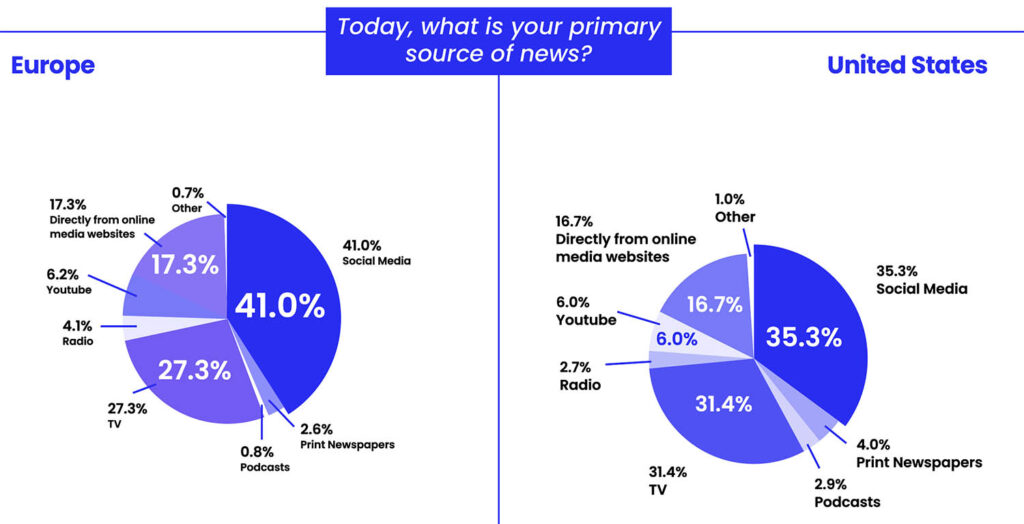
They are (over)confident they can spot fake news
If both groups are using social media as their main source of news, and since we know that fake news abounds, how confident were they that they could spot it when they saw it? Both groups were confident that they could recognize fake news.
For the US, 93.3% were confident they could spot it, with 39.3% saying they were very confident, and 54% saying they were somewhat confident.
Numbers were similar for Europe: 93% were confident they could spot it, with 33% saying they were very confident, and 60% saying they were somewhat confident.
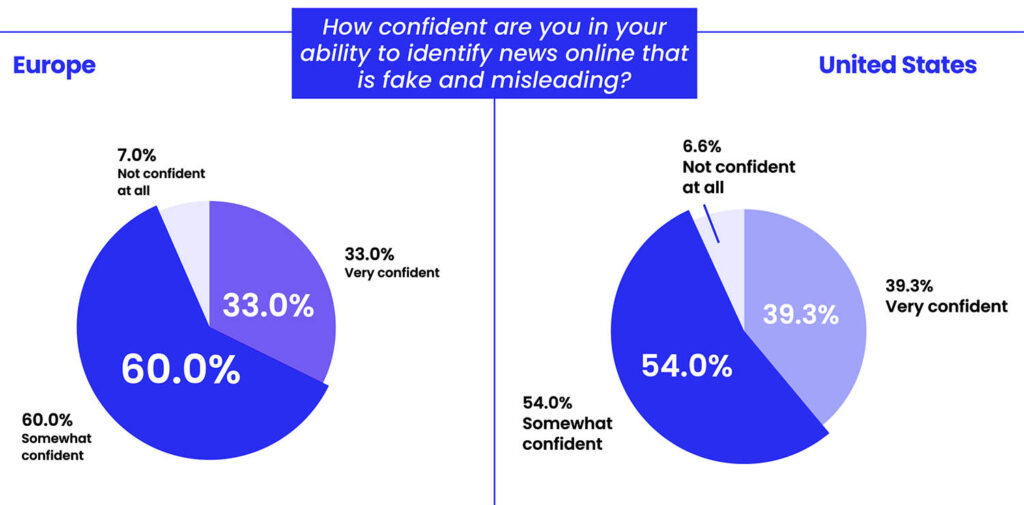
But they have also personally shared fake news by mistake
While both the US and European respondents were highly confident that they could recognize fake news when it appeared in their news feed, both groups had shared fake news by mistake. 38.2% of US respondents and 34.9% of Europeans had shared misleading information to others. Despite similar high responses around being able to recognize misleading content, it turns out that fake news creators are doing a better job at making deceptive content than our respondents are aware of.
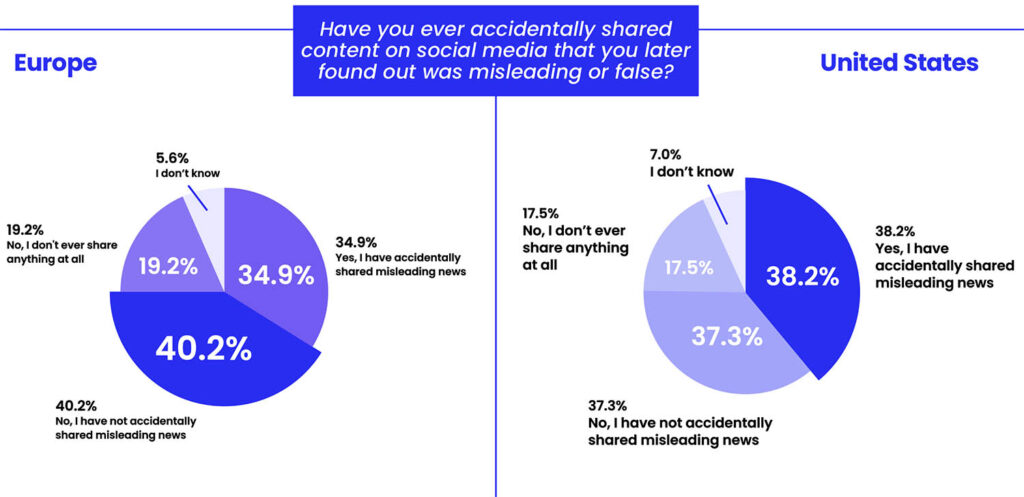
Summary
So far, we found little difference in our two respondent groups. Both were turning more towards social media for finding news over TV and other sources. And both groups were overconfident in their ability to spot fake news online.
Part 2: Encounters with Fake News and Misinformation
Knowing that fake new abounds online, we wanted to know more about our respondents’ encounters with it and how they responded.
Encounters with fake news on social media
We asked our respondents how often they were seeing fake news appear on their social media feeds. Both groups felt they weren’t seeing a lot of it. 55.9% of US respondents believed they only encountered fake news up to five times per week. However, European respondents were more confident they encountered it less, with 65.6% believing they only encountered fake news up to five times per week.
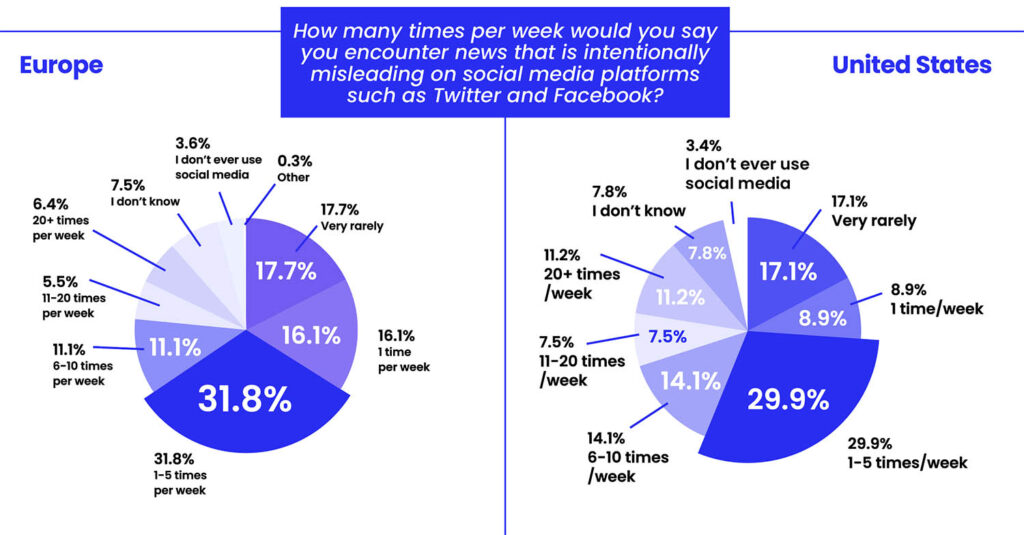
Encounters with fake news on search engines
When it came to search engines, US respondents had more confidence in the authenticity of search engine returns, with 60.6% of respondents believing they only encountered fake news up to five times per week. Europeans had the same level of confidence in search engines as social media, with 65.6% believing they only encountered fake news up to five times per week.
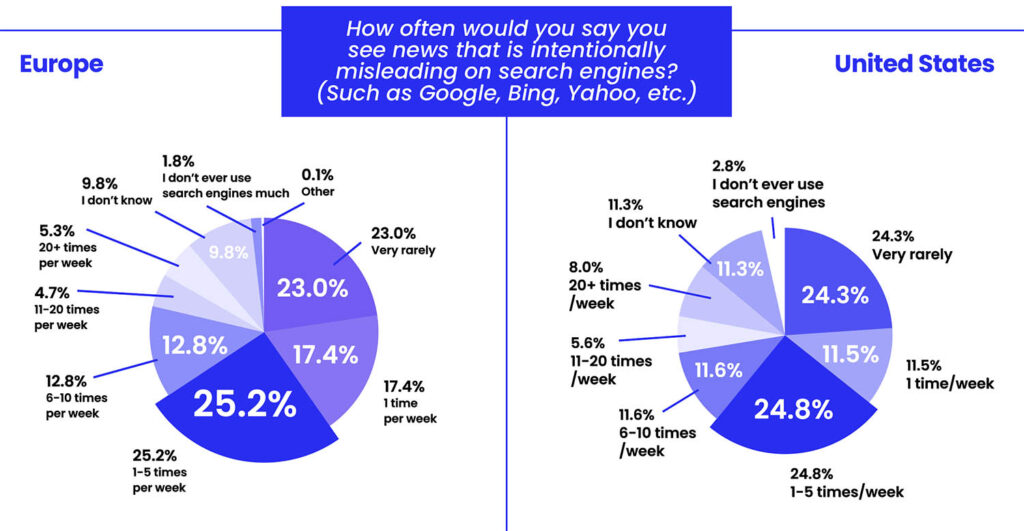
The six types of fake news people may encounter
According to The Columbia Journalism Review, there are six types of fake news: authentic material used in the wrong context, imposter news sites designed to look like brands we already know, fake news sites, fake information, manipulated content, and parody content.
The US was mostly seeing visually-based fake news. Respondents encountered manipulated content the most (26.8%) — photos and videos that are doctored, Photoshopped, or that contain deep fakes — along with authentic material used in the wrong context almost as much (24.3%).
European respondents encountered fake information the most (26.9%), along with authentic material used in the wrong context (24.1%).
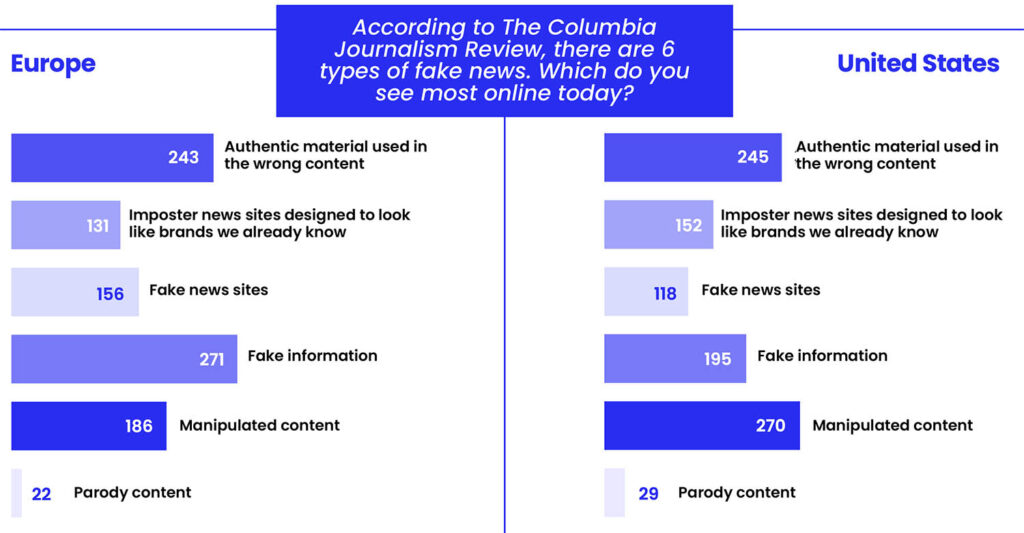
Summary
While our respondents believed they were seeing fake news online, our European respondents believed they were seeing it less somewhat frequently than our US respondents. Additionally, US respondents believe they were seeing fake news more on social media and less on search engines, perhaps attributing higher confidence levels to search engine returns being able to show the source of the content. European respondents placed the same confidence level on social media and search engines.
Part 3: Trust on the Internet
If fake news is content that can’t be trusted, what constitutes trusted information on the internet, and where can it be found?
Trusting websites with professionals behind them
First, we started with which kinds of websites our respondents trusted the most for accurate, verifiable content. Both of our groups trusted content from sites backed by professionals, including financial sites and legal sites. For the US respondents, medical websites were the most trusted (42.7%), and for our European respondents, government websites were the most trusted (46%). For both, ecommerce sites and the general internet were the least trusted.
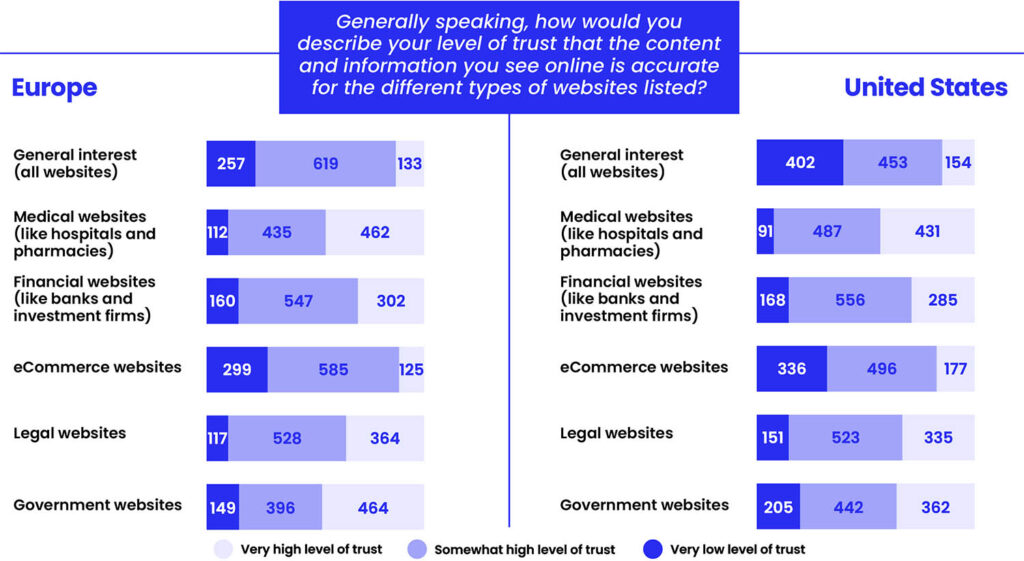
Who to trust to provide accurate news
When we asked our respondents to rate their level of trust on some one-to-one comparisons, we found that our US respondents tended to lean more towards more traditional, local sources of news and information. Our European respondents tended to value both traditional and digital sources about evenly.
US respondents trusted local news over national, and traditional and broadcast media by far over social media. Europeans, however, trusted national news over local, and valued traditional media, broadcast media, and social media the same.
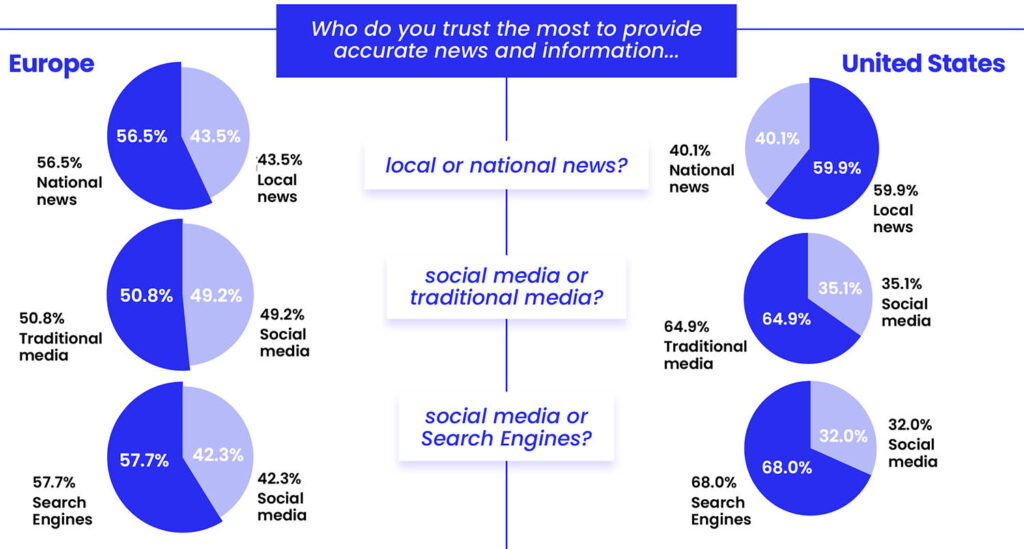
Both US and European respondents trusted search engines over social media. And both US and European respondents trusted Facebook over Twitter, but trusted Google over Facebook.
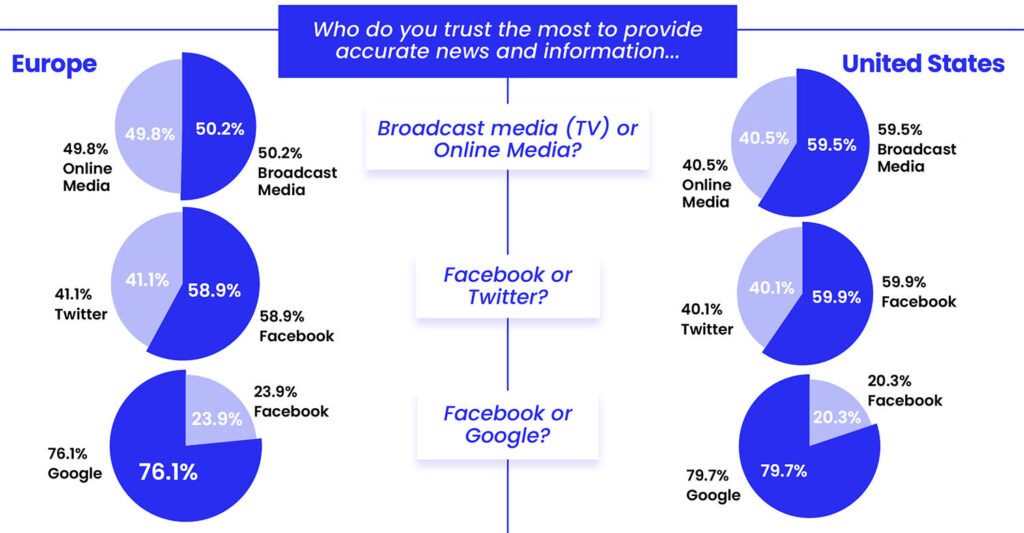
Which social media they trust the most
What about trusting different social media platforms? Both our US and European respondents rated Facebook, Twitter, and LinkedIn as their highest trusted platforms.
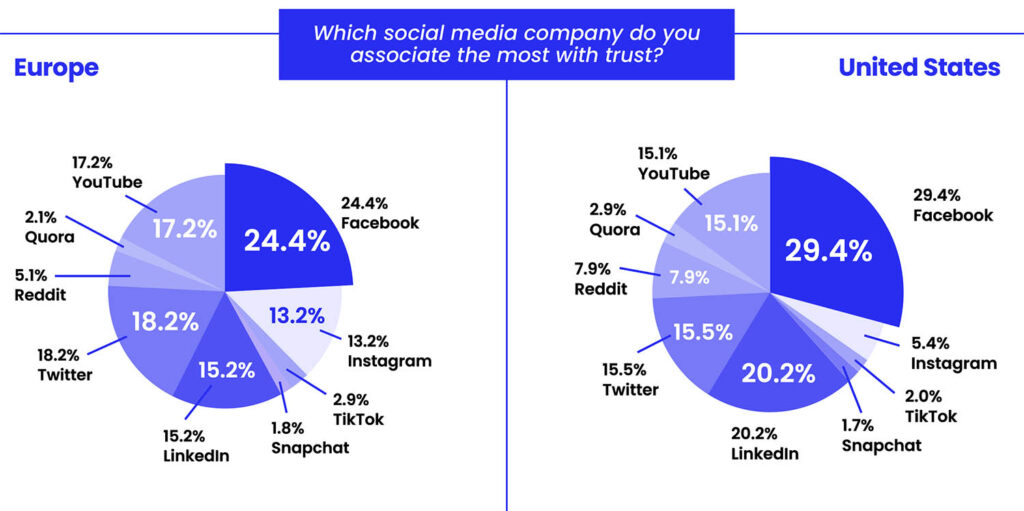
Which social media they trust the least
But when it came to platforms they trusted the least, both our US and European respondents also rated Facebook and Twitter as their least trusted, alongside TikTok.
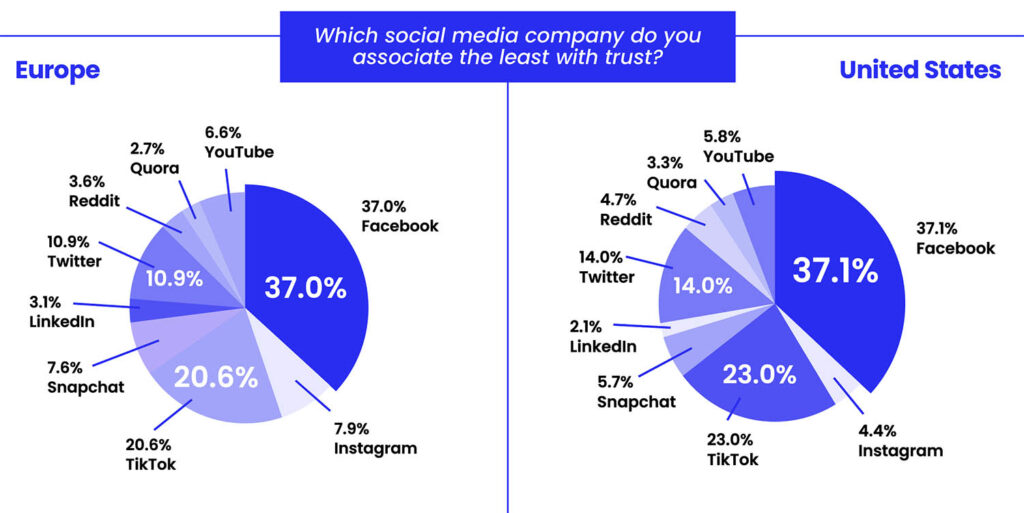
Summary
Both of our respondent groups stated that in terms of which websites they could trust, professional and government sites rated the highest, with ecommerce and general sites on the internet rating as least trusted. In terms of social media platforms, our respondents rated the same sites as their most trusted and least trusted. But in terms of drilling down into certain sources, US respondents tended to have more confidence in local, more traditional news sources, whereas Europeans tended to trust both traditional and online/digital sources.
Part 4: Impact of Fake News
Next, we wanted to understand the impact fake news had on our respondents in terms of behaviors or decisions, as well as how they respond to it.
The personal impact of fake news on behavior
We found that in terms of impact, our US respondents reacted to fake news by increasing their fact checking (38.8%). This was more than our European respondents did (34.6%), who replied that fake news had no impact on their lives (33.2%), which was more than our US respondents (24.8%).
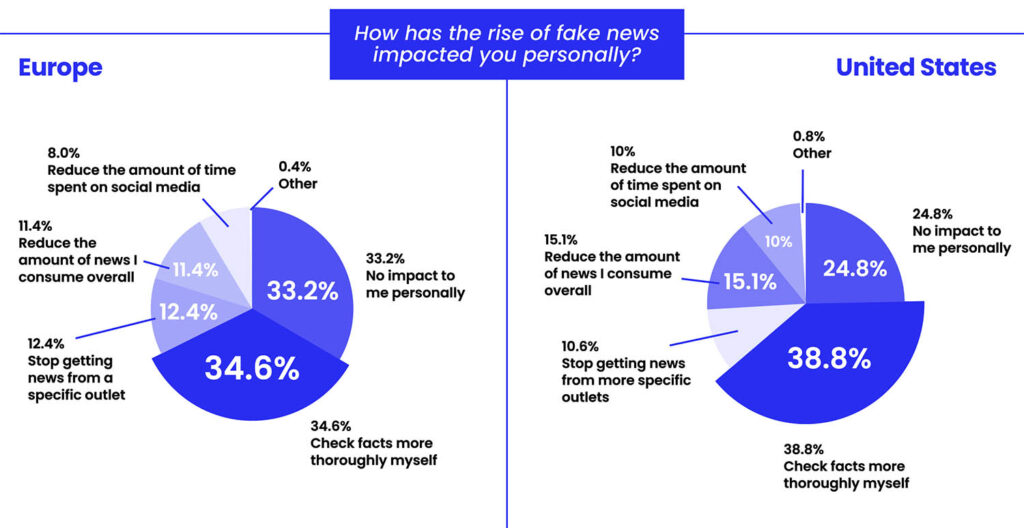
The personal impact of fake news on decisions
As for the impact on decisions, our US respondents saw a slightly elevated impact (39.9%) on their decisions, over our European respondents (34.9%). Conversely, our European respondents felt their decisions weren’t as impacted by fake news.
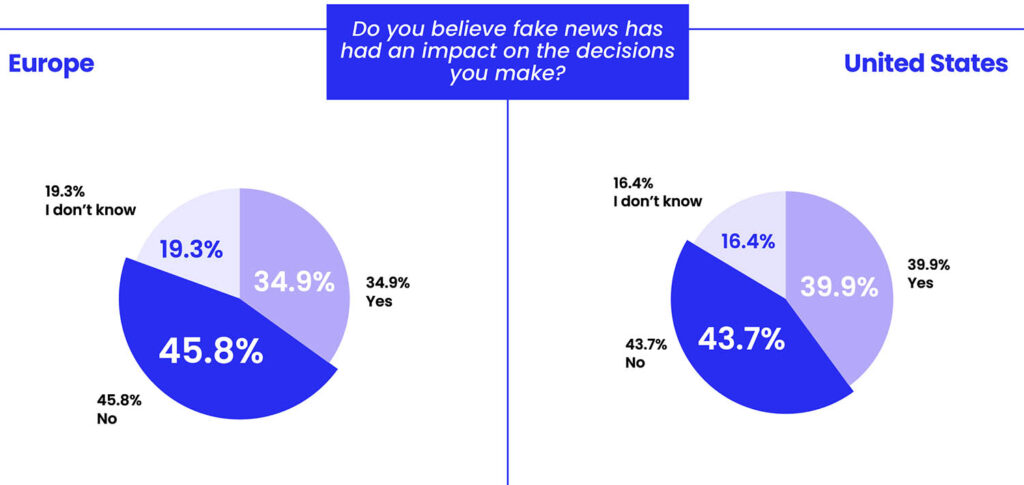
Responding to distrusted information
How did respondents react when encountering misleading information on a website? The majority of both of our groups replied similarly in that they sought out additional information from other sources to verify what they were seeing (US 63.2%, Europe 56.1%). However, the remainder of respondents tended to continue anyway knowing the information was misleading, or delay their actions.

How big of a risk is fake news
In regards to how big of a risk each group felt fake news poses to society, we found that Europeans saw fake news as much less of a threat when compared to terrorism (57.6%), data theft (63%), and climate change (75.2%). However, our US respondents believed that fake news was more of a threat to society (55%) than terrorism, and while they ranked it lower than data theft or climate change, the numbers were much closer than the European numbers, signaling that overall, the US respondents feel more threatened by fake news.
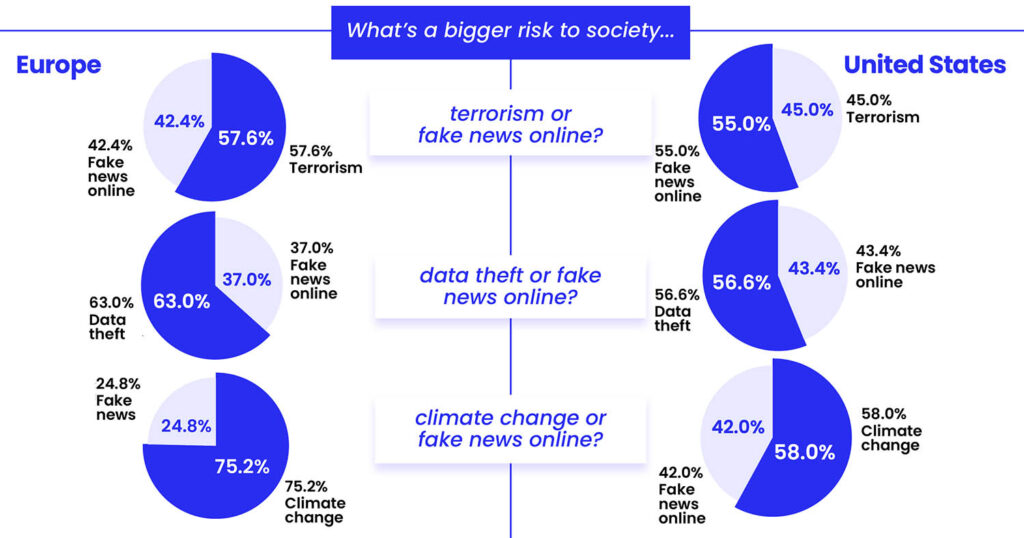
Fake new impacts elections — massively
This was also represented in how our US respondents felt fake new influenced the general elections (77.9%) and the 2020 Presidential election (70.4%). Europeans felt that fake news also influenced the elections in their countries, but a smaller amount (60.4%) felt they had.
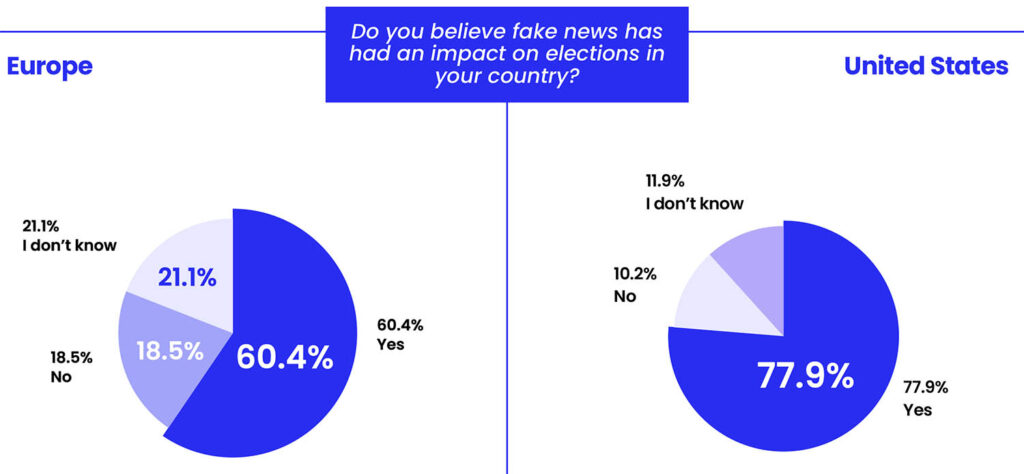
Summary
In terms of the impact of fake news, our respondents were about split in how they felt it impacted them personally. But in terms of threat or widespread influence, our US respondents deemed fake news more of a risk to society than the European respondents.
Part 5: Solving the Fake News Problem
We know that fake news abounds, and poses an impact to individuals and society. So how can it be solved?
Solving the fake news problem — but how?
When it comes down to who can solve fake news, our US respondents believed that fact-checking organizations (29.3%) would be key in stemming and reversing the flow of fake news, seconded by traditional news media (19.7% ). However, our European respondents believed that the government and regulators (24.8%) needed to take the lead, but also knew that traditional news media has a part to play too (21.2%).
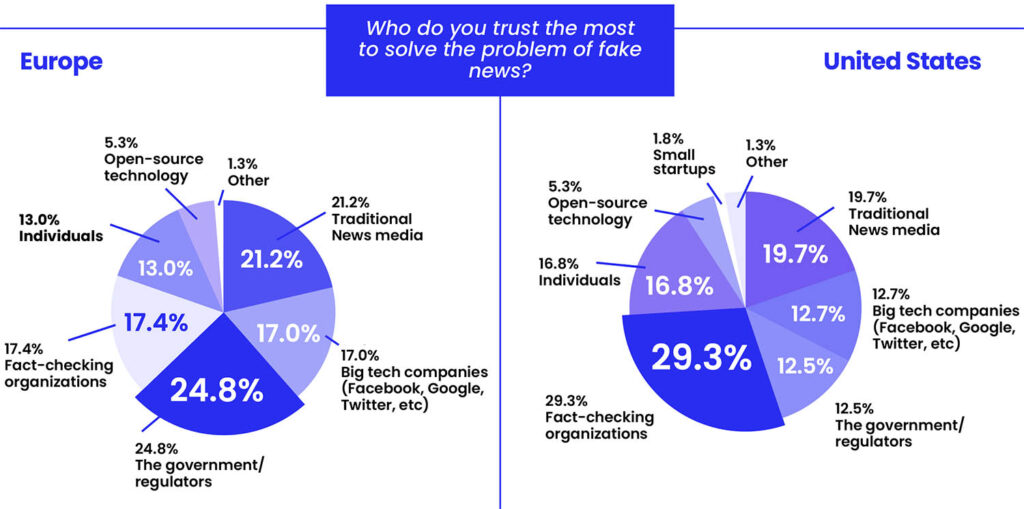
Is fake news anyone’s fault
In terms of laying the blame for fake news on anyone, our European respondents assigned fault nearly equally to news media, individuals, and government, but leaned more towards it being the fault of tech companies like Facebook, Google, and Twitter (34.4%). Our US respondents believed that the blame laid on individuals who knowingly create and share fake news (31.1%).
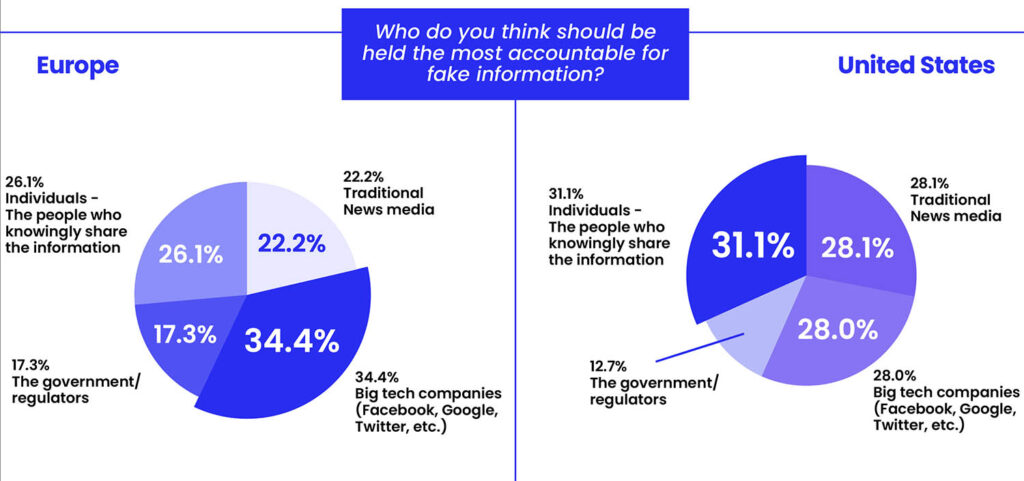
Should it be media or government
When asked if media and tech companies should try to solve the issue themselves, or if the government should step in, our groups responded similarly: about half (US 47.1%, Europe 50.6%) believed the government should step in to media and tech company practices to solve the issue. But European respondents gave the media and tech companies more leeway to be able to solve it on their own (36.6% as opposed to 30.6% from the US).
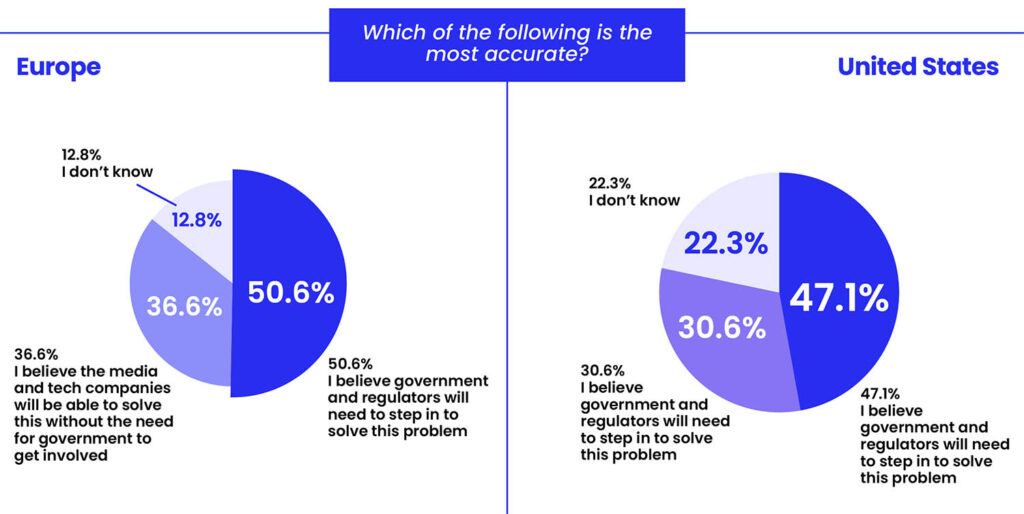
Is anyone addressing the problem of fake news in an effective way
When we asked if any entity was helping to solve the fake news problem now, our US respondents edged out news media as taking the lead, whereas our European respondents felt the government had the edge — though they felt all entities were only being somewhat effective.
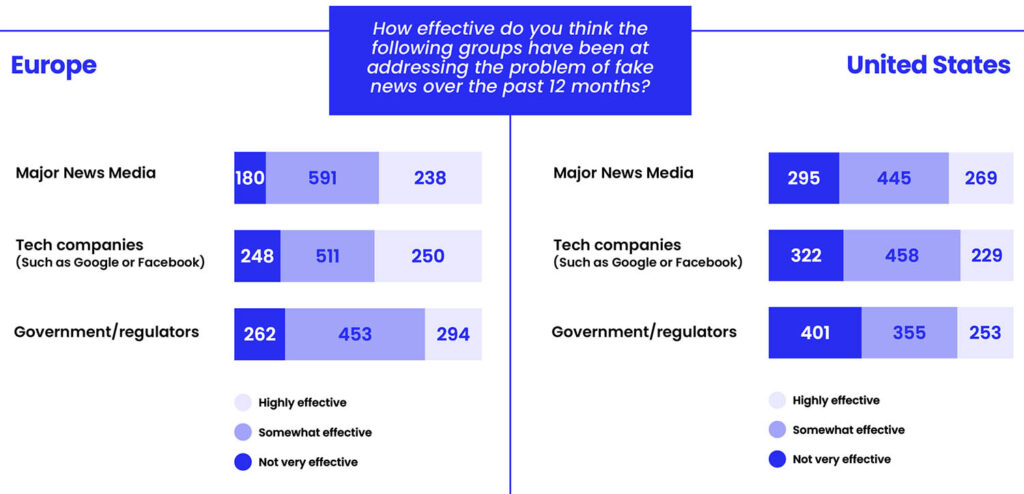
Should fake news be a crime
When asked if they would support regulations making the creation and spreading of fake news a crime, both of our groups responded similarly, with 66.3% from the US and 65.6% from Europe being in favor of it.
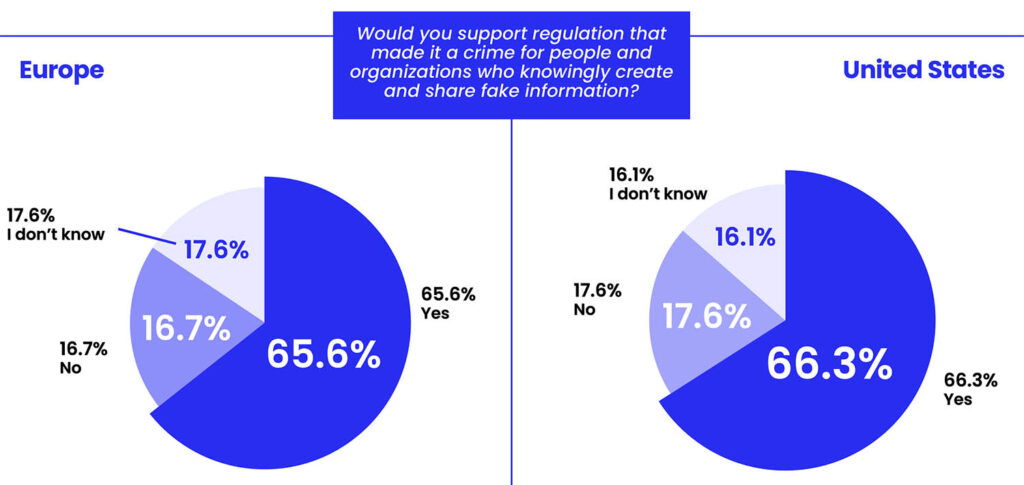
Solutions to Fake News: Increasing Trust Online
What kinds of solutions did our respondents have for solving the issue of fake news? Both groups believed that they would trust content more if they knew exactly what organization and author was behind the piece (US 46.7%, Europe 43.8%). They also felt that having a record of all the changes made to content since it was published, and the ability to find out more about the author, would also increase their trust in a piece of online content.
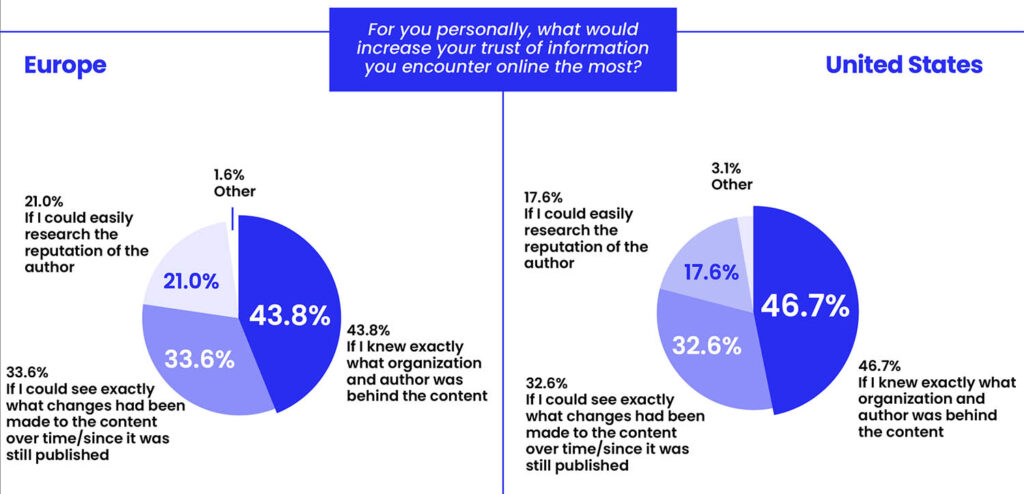
Solutions to Fake News: Impact on Trust
In terms of what solution would increase trust the most, both groups felt that all three applications would help increase trust. Our US respondents edged out more transparency around the organization and author behind the piece, while our European respondents liked knowing more about the authorship.
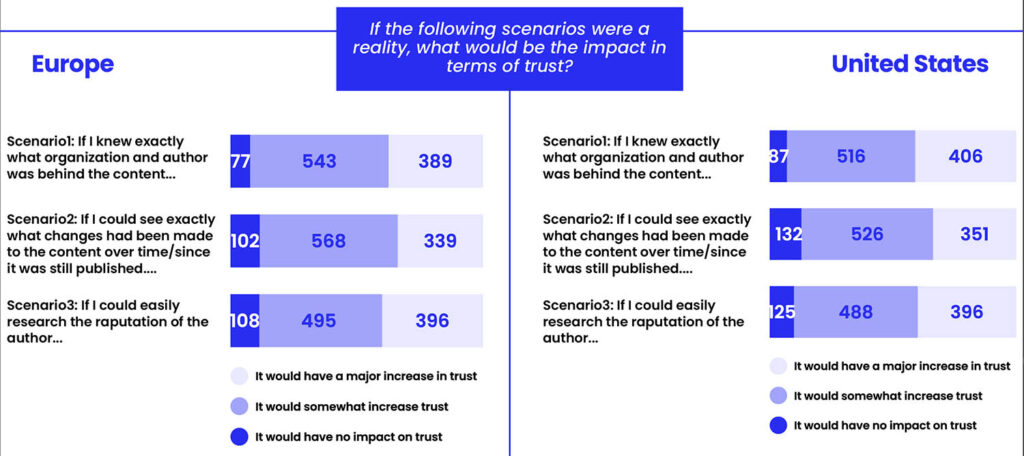
Solutions to Fake News: Trusting Unaffiliated Content
Both groups felt that any content that was not connected with an organization or author should be limited on search engines, with slightly more responding yes in the US (53.4%) than in Europe (50%).
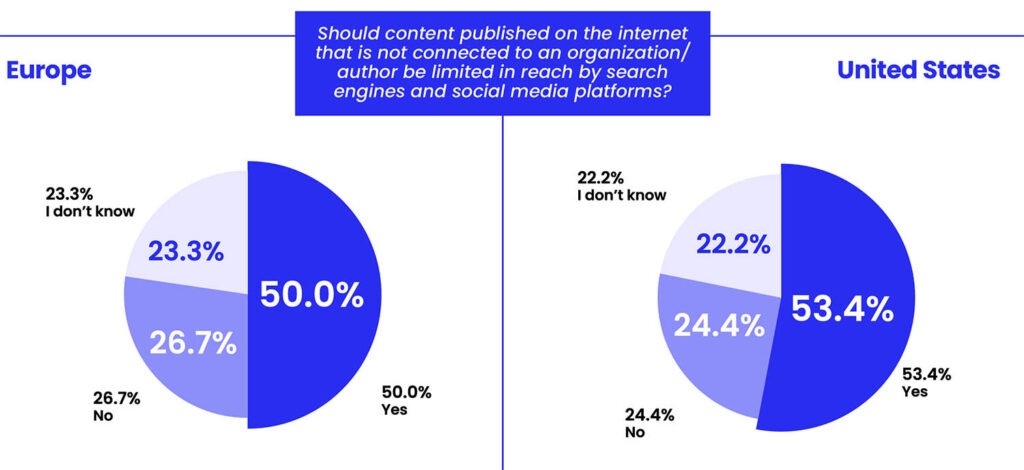
Solutions to Fake News: Trusting Required Documentation of Changes
A little over two-thirds of both groups as well believed that all content published online should be required to show a history of its changes (US 65.8%, Europe 64%).
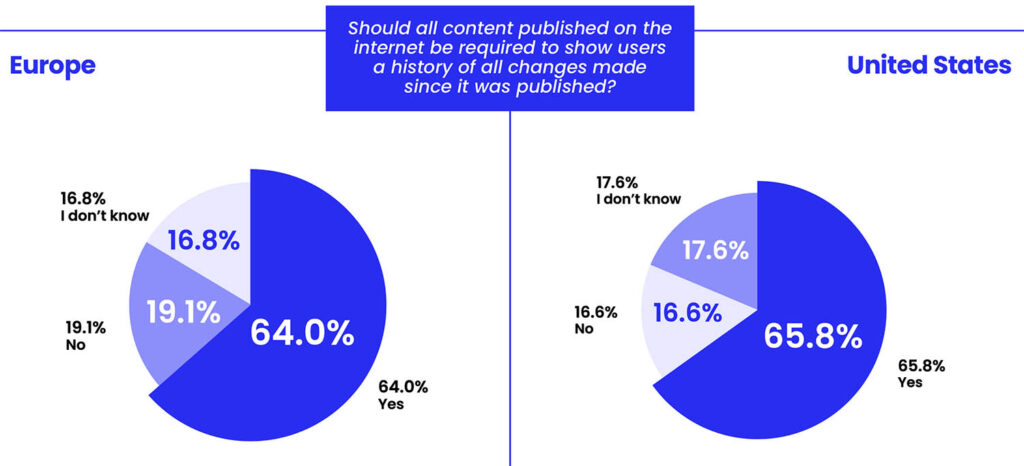
Summary
When it comes to solving the problem of fake news, our European respondents focused more on government actions, with the US believing that fact-checking organizations would be needed to stop the spread. However, both groups agreed that taking steps towards making authorship, document changes, and affiliations more transparent would go a long way in increasing trust in online content.
Part 6: Outlook For the Future
Finally, we wanted to know how optimistic or pessimistic our respondents were to fake news being solved in the future.
Solving the fake news problem — can it be done?
A little over a third of each group — 39.4% from the US and 36.6% from Europe — believed that fake news was solvable. But more European respondents (42.4%) believed that it couldn’t be solved, along with 35.2% from the US. Nearly a quarter of respondents in each group didn’t know if the problem could be solved.
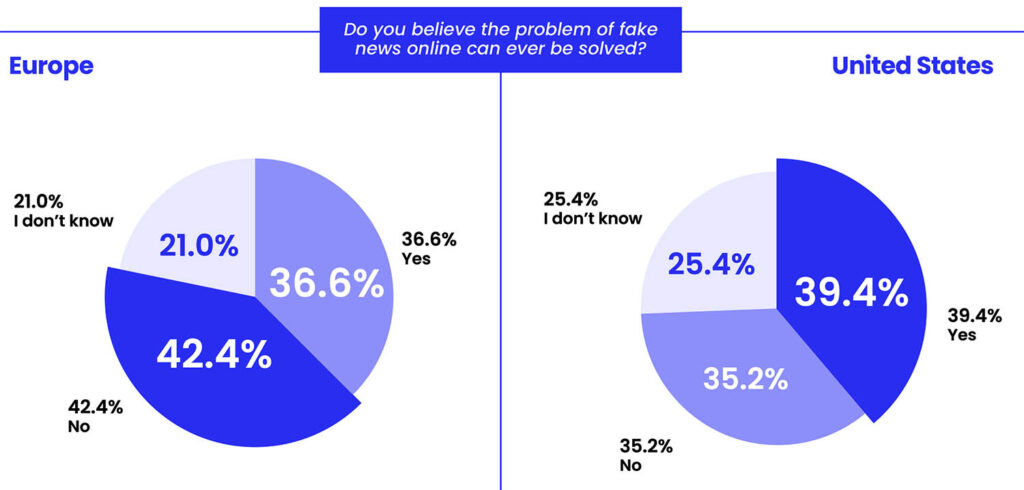
Will fake news continue to be an issue
As for whether fake news would continue to be an issue in five years, our US respondents thought it would worsen (35.5%) more so than European respondents (32%), who tended to believe that fake news would stay the same (34%). Only 25.9% of US respondents and 21.6% of European respondents believed that fake news would improve going forward.
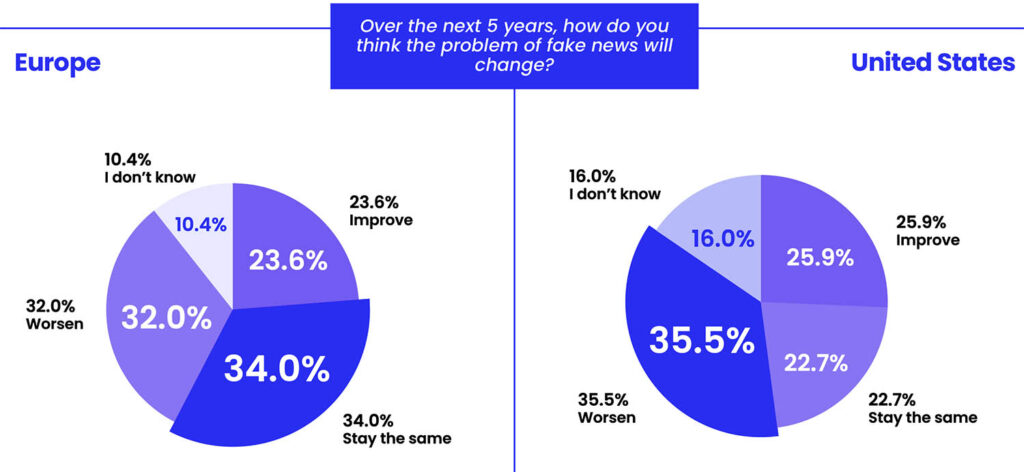
Conclusion
Whether in the US or Europe, our respondents were aware of and impacted by the presence of fake news in their daily lives, and saw impact on the world around them. And while both groups ranged from pessimistic to optimistic in their outlook, they all agreed that the solution to combating fake, misleading information would be to start making internet content more transparent. This would include more insight into who wrote it, where it was coming from, and how it had been changed since publication. Fake news is a solvable issue, and maybe the solution will come from fact-checking organizations, or governments, or individuals. But the way forward is through transparency and accountability.